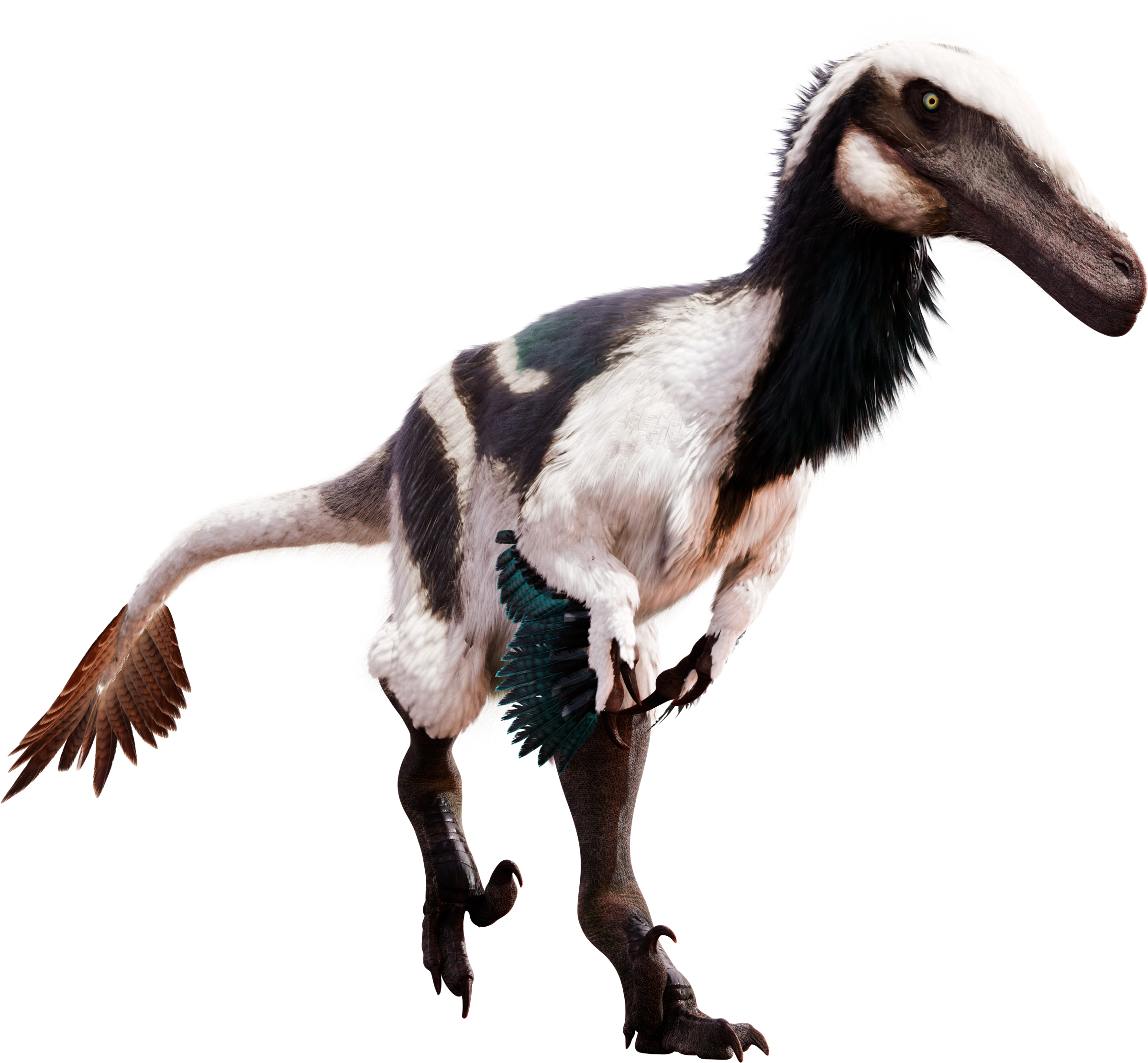The (Probably) Piscivorous Raptor
The elongated snout and conical, non-serrated teeth of Austroraptor indicate that it was mainly a fish-eater, resembling the dromaeosaur version of a spinosaurid.
Overview. Fishing isn't what one usually thinks of when one hears the word "raptor". One might think of a swift but powerful, scrappy, small to medium sized predator of other dinosaurs. An image from Jurassic Park might come to mind. Or maybe one might picture the Fighting Dinosaurs, a fossil assemblage which sees a Velociraptor locked in battle with a Protoceratops. Or perhaps one might imagine several Deinonychus fighting over a Tenontosaurus. But hailing from Late Cretaceous Argentina, the 5–6 m (16–20 ft) Austroraptor challenges our usual understanding of what a “raptor” can be. Despite being among the largest of the dromaeosaurs (the group colloquially known as “raptors”), this creature may very well have been a fish eater, based on the type of teeth it had. Discovered by Fernando Emilio Novas in the early 21st Century, this creature adds a very fascinating chapter to the saga of the dromaeosaurs and shows once again that evolution frequently puts new twists on a classic design.
Discovery. The holotype of Austroraptor (MML-195) was discovered in 2002 in the Bajo de Santa Rosa locality of the Campanian-Maastrichtian aged Allen Formation, in Río Negro, Argentina, by an expedition led by Fernando Emilio Novas. Novas described and named the specimen in 2008 along with Diego Pol, Juan Canale, Juan Porfiri and Jorge Calvo. Its genus name is derived from Latin “auster”, meaning “south wind” and “raptor”, meaning “thief”, and can be translated as “Southern Thief”. It should be noted that while “raptor” means thief, it has become closely associated with dromaeosaurs and to a lesser extent other especially dromaeosaur-like or bird-like dinosaurs, thus its name could almost be informally translated as “Southern Dromaeosaur”, though this is of course not the official translation. “Southern” was chosen due to it being discovered in the southern hemisphere. The species name “cabazai” honors Héctor "Tito" Cabaza, who founded the Museo Municipal de Lamarque where the specimen is housed. The holotype consists of a good deal of the skull and lower jaw, several vertebrae from the neck and torso, some ribs, a humerus, and somewhat complete legs. A second slightly smaller specimen (MML-220) was discovered in 2008 and was identified as Austroraptor in 2012 by legendary theropod researcher Phillip J. Currie and Ariana Paulina-Carabajal. This specimen shines additional light of the animal, particularly the lower arm, hand and foot, which are mostly missing from the holotype.
Evolution. Austroraptor was a member of the famous Dromaeosauridae or “raptors”. It belonged to a unique clade of dromaeosaurs called Unenlagiinae. These appear to have been exclusive or nearly exclusive to the southern hemisphere, and their distribution and unique features are probably a result of isolation due to the breakup of Pangea. Unenlagiines branched off early in dromaeosaur evolution, and differ from other dromaeosaurs in having longer snouts, a tail stiffened by lengthy chevrons and superior processes, a reduced second pedal ungual (i.e. a smaller “killing claw”), and a more backwards pointing pubis. Additionally, Unenlagiines differ from eudromaeosaurs, the clade which includes some the most recognizable genera including Velociraptor, Deinonychus, Saurornitholestes, and Dromaeosaurus, by having a subarctometatarsalian metatarsus, which is characterized by the pinched metatarsal III at the upper end, an adaptation for running, though not quite to the degree of the full arctometatarsus of tyrannosaurs, ornithomimids, and the dromaeosaur-like troodontids. Eudromaeosaurs lack the acrometatarsalian condition entirely and instead have stronger feet adapted more for grasping, and extra-enlarged digit II claws to go with it. Austroraptor may have been a close relative of the much smaller and unenlagiine Buitreraptor, which also lived in Argentina, but about 30 million years earlier.
Description and Ecology. Austroraptor lived in the Allen Formation which dates from 73 to 69 Ma. At this time Argentina was also home to several titanosaurian sauropods including Saltasaurus and Pellegrinisaurus, hadrosaurids including Bonapartesaurus, Kelumapusaura, and Lapampasaurus, whose ancestors had only recently migrated to South America, and the large abelisaurid theropod and likely apex predator, Carnotaurus. Smaller animals including early mammals and birds were also present. The environment of Argentina was probably lush and highly productive to support so many large herbivores.
Austroraptor is among the largest of the dromaeosaurs, with length estimates of 5-6 m (16-20 ft) and weight estimates of 91–227 kg (200.6–500.4 lb). While Austroraptor was not the region’s apex predator, it nevertheless enjoyed the privileges of a large predator, and may have only had to be concerned about predation or competition from large abelisaurs like Carnotaurus. Austroraptor had relatively long legs and a subarctometatarsus which would have allowed it to run quickly, and it is possible that it used this ability to run down small prey. While it’s sickle-shaped digit II pedal claws were proportionally smaller than in many other dromaeosaurs, these claws, which were held off the ground by hyperextension, still almost certinly would have played an important part in prey acquisition and dismemberment, probably used to restrain small prey and serve as a sort of meat hook to pull opposite the mouth when dismembering prey.
However, the preferred prey type may not have been terrestrial. It’s long snout and conical teeth, which lacked serrations and were fluted like those of spinosaurids, suggest that Austroraptor’s prey of choice was likely fish. In this scenario, in addition to running, Austroraptor’s long legs may have aided it in wading in the shallow wetlands that would have formed its hunting grounds. This could also explain Austroraptor’s unusually short arms, abnormal even for other unenlagiines, and perhaps unexpected for an animal that primarily runs down prey, as longer arms would be useful for seizing prey or balancing when maneuvering in a chase. A mostly piscivorous diet would make shorter arms less disadvantageous. This doesn’t necessarily negate Austroraptor hunting small terrestrial prey, but fish and other wetland creatures may have formed the backbone of its diet, making Austroraptor analogous to a giant toothy heron. Like other raptors and raptor-relatives, Austroraptor would have been almost fully feathered, except for the lower legs, which especially as a potential wader, would have been scaly like those of modern wading birds.
Extinction and Legacy. Austroraptor lived near the end of the age of dinosaurs, and though the geologic formation in which it was found only dates to 69 Ma, it is likely that Austroraptor, or something very much like it, lived until the end of the Cretaceous 66 million years ago. This would make it one of the very last of the dinosaurs. Its extinction was thus the same cause as all the non-avian dinosaurs: an asteroid twice the size of Mt. Everest crashed into the Gulf of Mexico with the force of 100 million megatons, 4.5 billion times the explosive power of the Hiroshima atom bomb that ended World War II. This caused a global firestorm which eradicated most land animals that couldn’t find shelter, and anything that survived would have then faced something like a nuclear winter, where a lack of sunlight and food guaranteed the extinction of 75% of all species, including nearly any terrestrial animals over 25 kilograms (55 pounds). Now all that remains of these most fascinating of raptors is dust and bones. All known bones are housed in the Museo Municipal de Lamarque in Rio Negro, Argentina. Austroraptor replica skeletal displays can also be seen at the Royal Ontario Museum in Toronto, Ontario, Canada, and the Science Museum of Minnesota in St. Paul, Minnesota, USA. Austroraptor made its on-screen debut this year (2023) in Season 2 of BBC and AppleTV’s dinosaur documentary Preistoric Planet, where it was portrayed as a piscivore.
Austroraptor FAQ
Austroraptor size / How big was an Austroraptor?
See height, weight, and length.
Austroraptor height / How tall was Austroraptor?
Austroraptor was probably about 1.78 meters (5.84 ft) tall, similar in height to an average human male.
Austroraptor weight / How much did an Austroraptor weigh?
Austroraptor probably weighed about 91–227 kg (200.6–500.4 lb).
How long was Austroraptor?
Austroraptor is thought to have been 5-6 m (16-20 ft) long.
What did Austroraptor eat?
Austroraptor ate meat, and its teeth and snout shape suggest that it may have specialized in eating fish, specifically.
What is Austroraptor’s closest living relative?
Like all dinosaurs, the closest relatives of Austroraptor are the only surviving lineage of dinosaurs today, the birds. As a dromaeosaurid or “raptor”, Austroraptor would have looked a lot like its avian relatives. Crocodilians, while not dinosaurs themselves, are also more distant cousins of dinosaurs.
Austroraptor family members / Austroraptor family / What kind of dinosaur was Austroraptor?
Austroraptor was a theropod (two-legged, mainly carnivorous dinosaurs) in the family Dromaeosauridae, also known as “raptors", making it a close cousin of famous species like Deinonychus, Utahraptor, and of course, Velociraptor!
Where did Austroraptor live? / Where was Austroraptor found?
Austroraptor lived in what is now the Patagonia region of Argentina.
When did Austroraptor live?
Austroraptor lived about 73-66 million years ago at the end of the Cretaceous Period.
What does Austroraptor mean? / Austroraptor name meaning
Austroraptor means “Southern Thief”.

